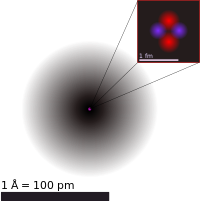
Photo from wikipedia
This investigation uses atomic properties derived from the quantum theory of atoms in molecules formalism to rationalize the infrared intensity of the stretching vibration that arises as a Lewis base… Click to show full abstract
This investigation uses atomic properties derived from the quantum theory of atoms in molecules formalism to rationalize the infrared intensity of the stretching vibration that arises as a Lewis base (B) is protonated (B-H mode). Moreover, the interacting quantum atom (IQA) partition is employed to evaluate the energetics of protonation. All calculations are performed at the CCSD/cc-pVQZ level except by the IQA analysis, which is carried out by means of the B3LYP/cc-pVQZ//CCSD/cc-pVQZ treatment. First, an efficiency scale is established for Lewis bases in terms of the electronic charge transfer potential. Next, this study shows that the intensity of the B-H stretching depends mostly on the electronic charge amount transferred to the proton. Thus, intensity data provide empirical assessment of Lewis base charge transfer efficiency. Finally, the group separation observed during correlation of proton affinities and electronic charge transfer potential is explained by the interaction energy between fragments of the protonated system.
Journal Title: International Journal of Quantum Chemistry
Year Published: 2017
Link to full text (if available)
Share on Social Media: Sign Up to like & get
recommendations!